.
9.01.2016
New Horizon's latest photos of Pluto: 'This part acts like a lava lamp'
The historic mission sent Nasa its highest-resolution images Thursday of dwarf planet’s Sputnik Planum, a region of pitted plains and a strange ‘X’ formation
.

An ‘X’ formation appears on the surface of Pluto in one of the newly released photos taken by New Horizons for Nasa. Photograph: Nasa/JHUAPL/SwRI
-
Icy, pitted plains and craters full of a red soot dot the landscapes of Nasa’s newest photos of Pluto, released late on Thursday.
New Horizons, the first spacecraft to ever reach Pluto in a historic mission last year, sent Nasa its highest-resolution photographs so far from the broad, rolling plains that drape the dwarf planet in a heart-shaped expanse. Nasa scientists have dubbed the region within the heart Sputnik Planum, after the first manmade satellite into space.
.

New Horizons’ highest-resolution swath of Pluto to the center of Sputnik Planum. Photograph: Nasa/JHUAPL/SwRI
.
The new images show that the low-lying surface is not totally flat, but rather a mix of pitted areas, 10 to 25 miles wide, that the researchers call “cells”. The cells have ridged margins and raised centers, visible thanks to shadows cast by a low sun, and some cells appear separated by trench or canal formations.
Researchers believed the strange surface patterns are formed by convection, as soft frozen nitrogen carries warm ice on to Pluto’s surface, where it evaporates en route to the edge of each cell. Liquid nitrogen may flow beneath the plains, emerging in rivers and moving the glaciers of nitrogen ice above.
“This part of Pluto is acting like a lava lamp,” said William McKinnon, deputy lead of the New Horizons geology and geophysics team. “If you can imagine a lava lamp as wide as, and even deeper than, the Hudson Bay.”
The “X” formation visible in one photo of the plains is probably the “quadruple junction of former convection cells”, New Horizons’ planetary astronomer Alex Parker tweeted.
.

Viking Terra. Photograph: Nasa/JHUAPL/SwRI
-
The darker patches scattered across the plain are probably chunks of dirty water icebergs floating in the denser nitrogen, the researchers said. They added that the pits are probably the results of sublimation, the direct transformation of solid ices to gas. The scientists believe Pluto has a reservoir of solid nitrogen that may be several miles deep.
From deep inside Pluto, a small amount of radioactive decay warms the dwarf planet, enough to lift the nitrogen up before it cools and falls for the cycle to begin again.
From another region, the reddish, cratered area called Viking Terra, New Horizons has relayed photos that show features smaller than half a city block.
In this area scientists have detected methane ices girdled round crater rims, as well as the accumulation of reddish brown tholins, tar-like particles which created reactions involving methane, nitrogen and the sun’s ultraviolet radiation. The tholins form a hazy “molecular rain” that drifts on to the surface, giving Pluto its distinctive burnt color along its craters, mountains and cliffs.
Researchers hypothesize that the tholins may actually ride the nitrogen ice flows beneath them, or along the dwarf planet’s winds.
Nasa also released a new video describing the possible ice volcanos, also called cryovolcanos, believed to exist around the planet. Cryovolcanos spew frozen, volatile chemicals, such as ammonia and methane, rather than the ash and lava that erupts from volcanos on Earth.
.

Probable cryovoclanos. Photograph: Nasa/JHUAPL/SwRI
-
The rippled slopes of the 100-mile-wide Wright Mons, for instance, suggest the flow of melting, volatile chemicals from the mouth of the mountain, a depression estimated to be 35 miles wide. New Horizons did not capture images of eruptions, but cryovolcanos if confirmed would provide clues to how Pluto formed.
New Horizons successfully flew by Pluto in July 2015, and has only transmitted a fraction of the total data it recorded; scientists expect a full download sometime this summer. The spacecraft is now heading off past the edge of the solar system, into a zone called the Kuiper belt, and should reach its next destination, a body called 2014MU69, in 2019.
Quelle: theguardian
---
Probing the Mysterious Glacial Flow on Pluto’s Frozen ‘Heart’
“Since its discovery, Pluto has proven consistently troublesome to the theorist.”
– Sir Patrick Moore, The Observer’s Book of Astronomy (1971)
Written 45 years ago, these words are more appropriate today than Moore could have ever imagined. Greetings, I’m Dr. Orkan Umurhan, a scientist on New Horizons’ Geology and Geophysics Investigation (GGI) Team.
Pluto’s surface geology alone – from the bladed terrain of Tartarus Dorsa to the mysterious dark mound of Morgoth Macula (just to mention a few informally named features with perplexing geologies) – continues to stump all of us on the New Horizons Geology and Geophysics Investigation (GGI) team.
Over the last month, I’ve been examining numerous theoretical and modeling questions to attempt to explain the processes at work within Pluto’s frozen plains, known as Sputnik Planum (SP). In a separate, yet parallel vein, I’m also studying the nature of glacial flows onto SP from the highlands bordering its eastern shoreline. In this blog, I will talk about the glacial flow problem.
First, let’s look at some pictures of glacial flow on Pluto’s frozen plains.
.
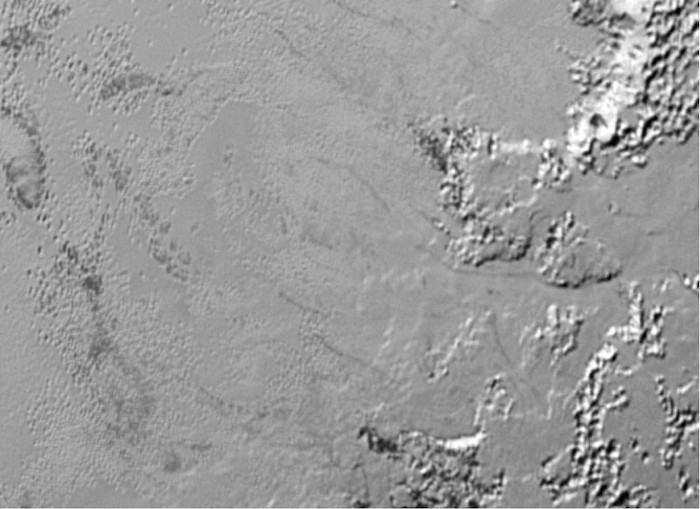
A nearly top-down view of Pluto’s icy plains, showing dark lanes reminiscent of glacial moraines. Credits: NASA/JHUAPL/SwRI
.
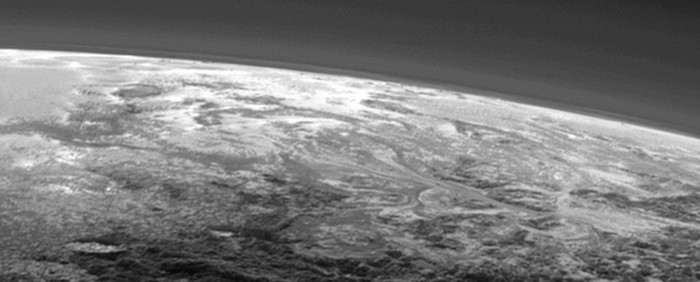
This low incidence angle indicates flow patterns from the lower right of the image, extending to the center of Pluto’s informally-named Sputnik Planum. Credits: NASA/JHUAPL/SwRI
-
These are two views of the same part of the eastern side of SP—one is a nearly overhead snapshot, while the other one is a very low-incidence angle image, dramatically displaying the relief of the landscape. In the overhead image you can see dark streaks emanating from the right leading onto the open plane tracing a lobate pattern – kind of like hot wax moving down an inclined plane. The dark materials are reminiscent of glacial moraines seen on Earth, but because this is Pluto, we have no idea what this dark material is, and whether or not the patterns we see are indeed moraines in the traditional terrestrial sense.
However, we do know what our colleagues on the New Horizons Composition team tell us: they have pretty solidly (ahem!) determined that the surface material on and in the near vicinity of SP is mainly made up of nitrogen, carbon monoxide, and methane ices, although their relative proportions are not yet determined.
In my initial considerations, I assume the flowing material is made of mostly nitrogen with some carbon monoxide, both of which have similar molecular bond structures. Based on what little lab work has been done on their properties under cold temperatures characteristic of Pluto’s surface (-390 degrees Fahrenheit or 38 Kelvin), these volatiles ought to flow more slowly than silly putty, but much faster than glacial water ice on Earth.
The response timescales appropriate for these volatiles with the scale and relief of the highlands seen around Sputnik Planum leads us to the geophysical insight that these high relief structures (icy mountains) are probably not made up of any of these pure volatile ices, because they would have flattened out a long time ago. Instead, we speculate that the highlands are more likely made of a very strong structurally rigid water ice “bedrock” covered by a very thin coating of nitrogen and/or carbon monoxide ice.
This is where I come in: I fold all of this laboratory information about the volatile ices, as well as various geophysical insights into a numerical simulation platform I built a year ago that models glacial flow. This tool is used to examine various scientific hypotheses from me and other members of the geology team.
.
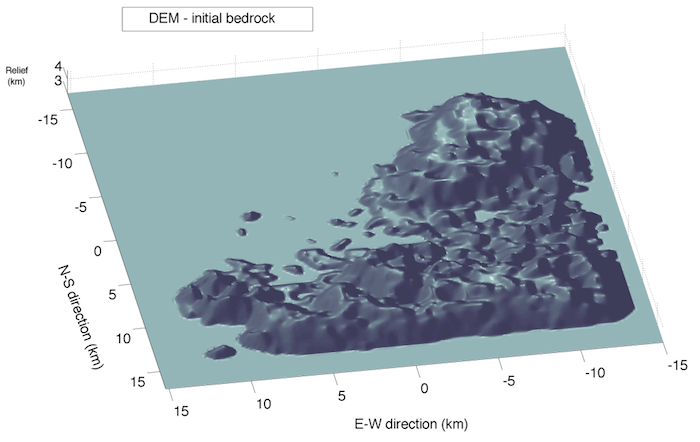
Credits: Paul Schenk, Ross Beyer and Orkan Umurhan
-
For example, one task is to examine possible scenarios explaining how the observed lobate pattern (think hot wax) comes about, and whether or not a nitrogen glacial model can explain what we see. To accomplish this, I start with a Digital Elevation Model (DEM) seen above, using stereo imaging of Pluto’s surface with vertical relief on the order of .6 miles (1 kilometer). I use this model as my bedrock surface—then I add nitrogen ice and study the response.
.
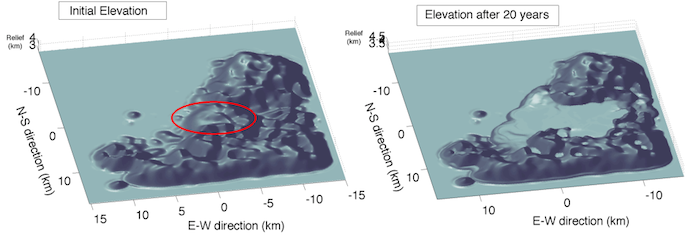
Credits: Orkan Umurhan
-
To show you an example of the kind of response the model can exhibit, consider the figure above, where I take this surface bedrock and add glacial nitrogen ice, indicated by the red ellipse on the left figure. To this model I also add a feature representing the uniform accumulation of deposited nitrogen ice, in the amount of about one yard (one meter) per year. The outflow state is shown in the right panel. In this artificial example, I have put in nearly 400 yards (400 meters) of ice inside the circled red region. The final flow state – including nice frontal lobes – gets there in about 20 Earth years. This is fast! You can also see accumulation of nitrogen ice inside of craters; this is because the steady deposition of ice also runs down steep-sided slopes and collects inside.
In understanding complex Pluto, progress is slow, but we are making progress. Stick around for the next installment of my blog, in about a month, when I will have more cool results!
Quelle: NASA
-
Update: 15.01.2016
.
Possible Ice Volcano on Pluto Has the ‘Wright Stuff’
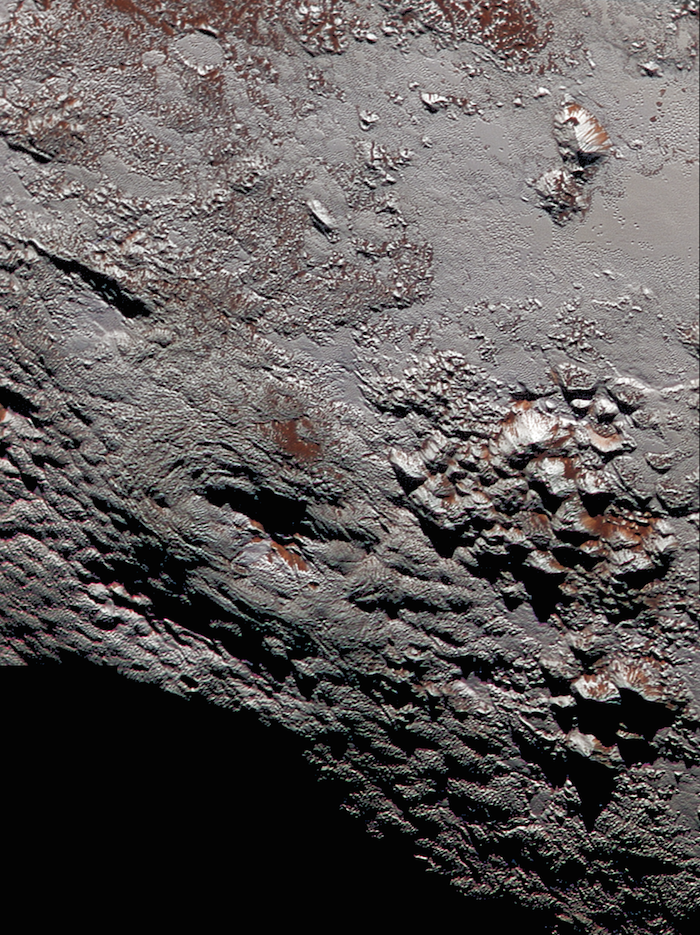
Wright Mons in Color. This composite image of a possible ice volcano on Pluto includes pictures taken by the New Horizons spacecraft’s Long Range Reconnaissance Imager (LORRI) on July 14, 2015, from a range of about 30,000 miles (48,000 kilometers), showing features as small as 1,500 feet (450 meters) across. Sprinkled across the LORRI mosaic is enhanced color data from the Ralph/Multispectral Visible Imaging Camera (MVIC), from a range of 21,000 miles (34,000 kilometers) and at a resolution of about 2,100 feet (650 meters) per pixel. The entire scene is 140 miles (230 kilometers) across.
Credits: NASA/JHUAPL/SwRI
-
Scientists with NASA’s New Horizons mission have assembled this highest-resolution color view of one of two potential cryovolcanoes spotted on the surface of Pluto by the New Horizons spacecraft in July 2015.
This feature, known as Wright Mons, was informally named by the New Horizons team in honor of the Wright brothers. At about 90 miles (150 kilometers) across and 2.5 miles (4 kilometers) high, this feature is enormous. If it is in fact a volcano, as suspected, it would be the largest such feature discovered in the outer solar system.
Mission scientists are intrigued by the sparse distribution of red material in the image and wonder why it is not more widespread. Also perplexing is that there is only one identified impact crater on Wright Mons itself, telling scientists that the surface (as well as some of the crust underneath) was created relatively recently. This is turn may indicate that Wright Mons was volcanically active late in Pluto’s history.
.
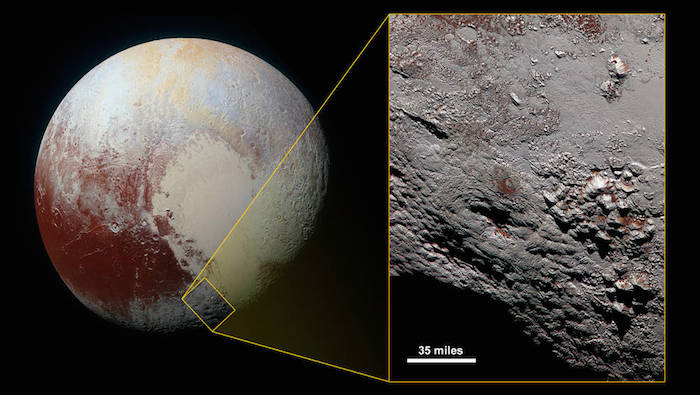
---
Pluto’s Haze in Bands of Blue
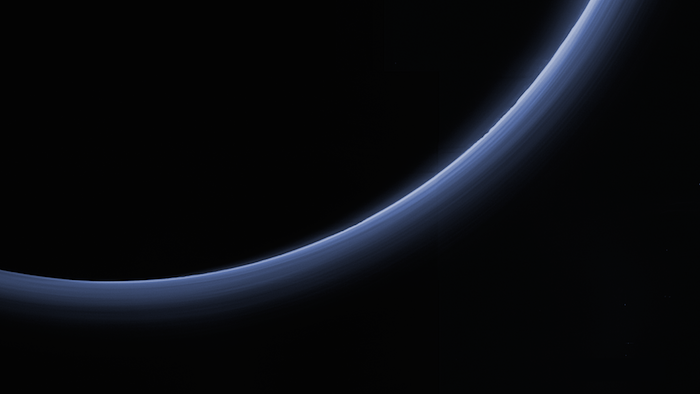
This processed image is the highest-resolution color look yet at the haze layers in Pluto’s atmosphere. Shown in approximate true color, the picture is constructed from a mosaic of four panchromatic images from the Long Range Reconnaissance Imager (LORRI) splashed with Ralph/Multispectral Visible Imaging Camera (MVIC) four-color filter data, all acquired by NASA’s New Horizons spacecraft on July 14, 2015. The resolution is 0.6 miles (1 kilometer) per pixel; the sun illuminates the scene from the right.
Scientists believe the haze is a photochemical smog resulting from the action of sunlight on methane and other molecules in Pluto’s atmosphere, producing a complex mixture of hydrocarbons such as acetylene and ethylene. These hydrocarbons accumulate into small particles, a fraction of a micrometer in size, and scatter sunlight to make the bright blue haze seen in this image.
As they settle down through the atmosphere, the haze particles form numerous intricate, horizontal layers, some extending for hundreds of miles around Pluto. The haze layers extend to altitudes of over 120 miles (200 kilometers).
Adding to the stark beauty of this image are mountains on Pluto’s limb (on the right, near the 4 o’clock position), surface features just within the limb to the right, and crepuscular rays (dark finger-like shadows to the left) extending from Pluto’s topographic features.
Quelle: NASA
.
Update: 23.01.2016
.
Young at Heart: Pluto's Ice Only 10 Million Years Old
Pictures are still filtering back from NASA’s New Horizons close-up of Pluto last year and one of the biggest surprises so far comes from the region informally known as Sputnik Planum. There’s a lack of craters on its surface, making it a unique area on Pluto and a rare spot in the solar system — it turns out it could be very young terrain indeed.“What I did was take the pictures that we have seen — the amazing pictures! — and calculate, based on Pluto’s orbital environment, what the impact rate and therefore the surface age of Sputnik Planum must be,” wrote planetary scientist David Trilling in an email to Discovery News.
“There have been lots of press releases describing various aspects of Sputnik Planum, but, as far as I know, this is the first time that the age estimate of 10 million years or younger appears in the peer-reviewed literature,” added Trilling, an assistant professor of physics and astronomy at Northern Arizona University.
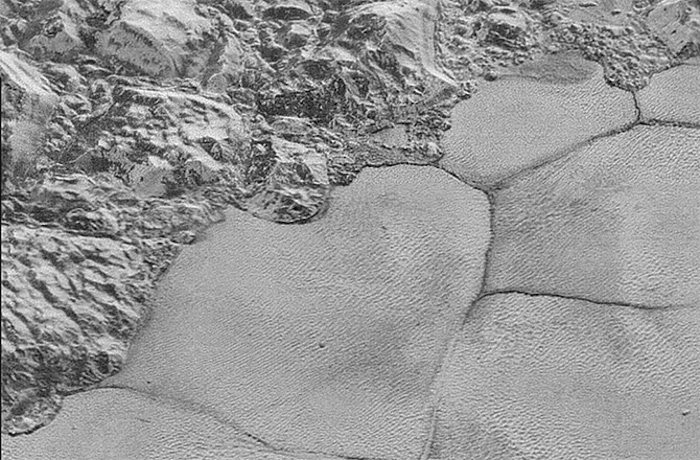
Trilling’s study, which is in press at PLOS One, mentions three ways the resurfacing could take place:
Nitrogen ice on the surface could be “relaxing” if it is viscous, getting rid of any craters created by meteroids.
Ice on the bottom could be rising up and replacing ice at the top, somewhat like how a lava lamp works.
The ice could be partially melted at its bottom and from time to time, erupt on to the surface as cryo-lava.
As for where the meteorites are coming from, Trilling points out that Pluto is in a zone filled with smaller Kuiper Belt objects. From time to time, these small bodies crash into Pluto. Trilling’s math shows that this happens roughly every 10 million years, which would explain why Sputnik Planum appears so young.
Trilling’s research is mostly focused on near-Earth asteroids, but Pluto caught his attention not only because of the “astounding” images, but also the lack of craters. He’s also hopeful that New Horizons will be funded to look at another Kuiper Belt object up close in 2018. If that happens, Trilling will be on the lookout for more “crater-free patches” to nail down more information about the solar system’s evolution.
.

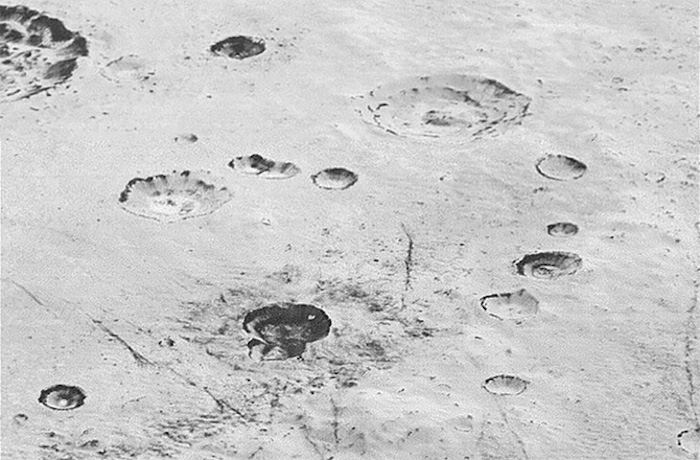
Quelle: D-News
-
Update: 30.01.2016
.
Pluto’s Widespread Water Ice
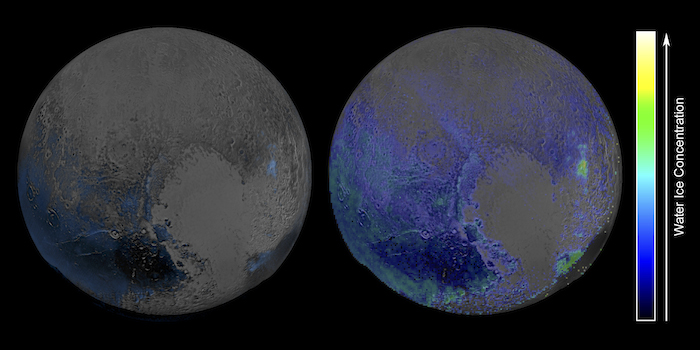
Data from NASA’s New Horizons spacecraft point to more prevalent water ice on Pluto’s surface than previously thought.
This false-color image, derived from observations in infrared light by the Ralph/Linear Etalon Imaging Spectral Array (LEISA) instrument, shows where the spectral features of water ice are abundant on Pluto’s surface. It is based on two LEISA scans of Pluto obtained on July 14, 2015, from a range of about 67,000 miles (108,000 kilometers).
The scans, taken about 15 minutes apart, were stitched into a combined multispectral Pluto “data cube” covering the full hemisphere visible to New Horizons as it flew past Pluto. A data cube like this is a three-dimensional array in which an image of Pluto is formed at each LEISA-sensitive wavelength.
Water ice is Pluto's crustal "bedrock,” the canvas on which its more volatile ices paint their seasonally changing patterns. Initial New Horizons maps of Pluto's water ice bedrock compared LEISA spectra with a pure water ice template spectrum, resulting in the map at left.
A disadvantage of that technique is that water ice's spectral signature is easily masked by methane ice, so that map was only sensitive to areas that were especially rich in water ice and/or depleted in methane. The much more sensitive method used on the right involves modeling the contributions of Pluto's various ices all together. This method, too, has limitations in that it can only map ices included in the model, but the team is continually adding more data and improving the model.
The new map shows exposed water ice to be considerably more widespread across Pluto's surface than was previously known — an important discovery. But despite its much greater sensitivity, the map still shows little or no water ice in the informally named places called Sputnik Planum (the left or western region of Pluto’s “heart”) and Lowell Regio (far north on the encounter hemisphere). This indicates that at least in these regions, Pluto's icy bedrock is well hidden beneath a thick blanket of other ices such as methane, nitrogen and carbon monoxide.
Credit: NASA/Johns Hopkins University Applied Physics Laboratory/Southwest Research Institute
.
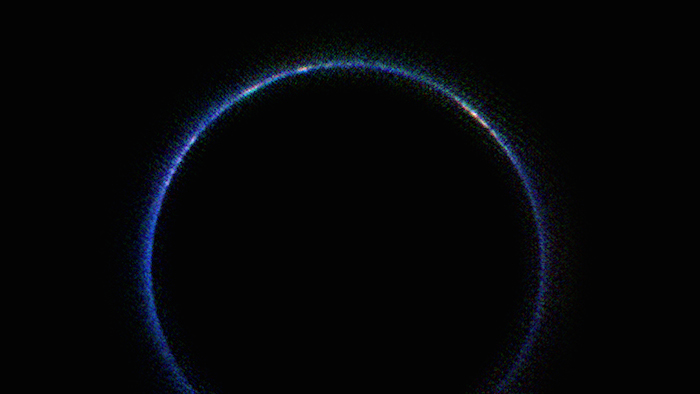
Pluto’s Blue Atmosphere in the Infrared
Release Date: January 29, 2016
Keywords: LEISA, Pluto, Ralph
This image from NASA’s New Horizons spacecraft is the first look at Pluto’s atmosphere in infrared wavelengths, and the first image of the atmosphere made with data from the New Horizons Ralph/Linear Etalon Imaging Spectral Array (LEISA) instrument.
In this image, sunlight is coming from above and behind Pluto. The image was captured on July 14, 2015, while New Horizons was about 112,000 miles (180,000 kilometers) away. The image covers LEISA’s full spectral range (1.25 to 2.5 microns), which is divided into thirds, with the shortest third being put into the blue channel, middle third into the green channel, and longest into the red channel. North in this image is around the 10 o’clock position.
The blue ring around Pluto is caused by sunlight scattering from haze particles common in Pluto's atmosphere; scientists believe the haze is a photochemical smog resulting from the action of sunlight on methane and other molecules, producing a complex mixture of hydrocarbons such as acetylene and ethylene. These hydrocarbons accumulate into small particles – a fraction of a micrometer in size – which scatter sunlight to make the blue haze. The new infrared image, when combined with earlier images made at shorter, visible wavelengths, gives scientists new clues into the size distribution of the particles.
The whitish patches around Pluto’s limb in this image are sunlight bouncing off more reflective or smoother areas on Pluto's surface – with the largest patch being the western section of the informally named Cthulhu Regio. Future LEISA observations returned to Earth should capture the remainder of the haze, missing from the lower section of the image.
Quelle: NASA
-
Update: 5.02.2016
.
Pluto might have icebergs that float in frozen nitrogen
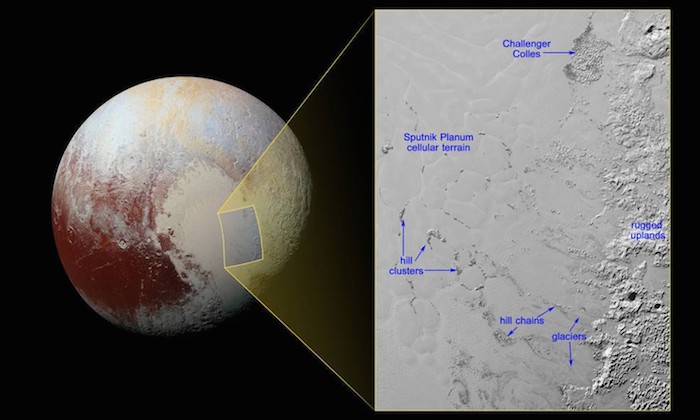
Hills of water ice on Pluto ‘float’ in a sea of frozen nitrogen and move over time like icebergs in Earth’s Arctic Ocean—another example of Pluto’s fascinating geological activity. (NASA/JHUAPL/SwRI)
Pluto is weird. Good weird, but definitely weird. The latest findings from NASA's New Horizons mission help confirm that beautiful weirdness: According to the latest scientific analysis of photos and data from the July flyby, Pluto is home to rock-hard glaciers made of water ice (note: planetary scientists use the terms "water ice" or "frozen water" instead of the more obvious "ice," because ice on other planets can be made of all sorts of molecules other than good old H2O).
These water ice glaciers float around on frozen nitrogen, which is much more common on the frigid dwarf planet. Because of the temperature on Pluto (minus-380 degrees Fahrenheit, on average), water ice glaciers are likely as hard as mountains made of rock are on Earth. Meanwhile, nitrogen – which doesn't even freeze until it hits minus-346 degrees – is icy but flowing, like glaciers on Earth.
That water ice may be hard as rock, but it's still less dense than frozen nitrogen. NASA scientists believe the water ice hills break apart and are carried atop the nitrogen flows, causing them to move in chains and cluster together based on the flow pattern.
In some areas of Sputnik Planum (an informal name for the plains of ice flows that sit in Pluto's "heart") these water ice mountain clusters span 12 miles across.
The informally named Challenger Colles (a tribute to the lost crew of NASA's Challenger shuttle), which is 22 miles by 37 miles across, could be a cluster of "beached" water ice mountains shoved into place by the nitrogen flows, according to the mission scientists.
Pluto's surprisingly wealth of geological activity does make its "dwarf planet" status hard to swallow for some. But whatever this little world is categorized as, one thing is for certain: It's a very cool place.
Quelle: The Washington Post
4749 Views
